|
Monetary Policy Keynesian View: FED |
- Summary (IMPORTANT - KNOW THIS)
- Monetary policy cause-effect chain: summary
- Online Lecture
- Review: Short Answer
- Review: Multiple Choice
- Assignments
- Monetary Policy Summary
OPTIONAL: http://www.federalreserveeducation.org/fed101/policy/basics.htm
I. Introduction
A. Objectives of Monetary Policy1. The fundamental objective of monetary policy is to aid the economy in achieving full-employment output with stable prices.a. To do this, the Fed changes the nation’s money supply.b. To change money supply, the Fed manipulates size of excess reserves held by banks (see chapter 15).
c. the Fed has three tools to do this
- Open Market Operations (OMO)
- changing the discount rate (DR)
- changing the required reserve ratio (RR)
2. Monetary policy has a very powerful impact on the economy, and the Chairman of the Fed’s Board of Governors, Ben Bernanke currently, is sometimes called the second most powerful person in the U.S.
B. Functions of The Federal Reserve System (Fed)
1. issue currency = Federal Reserve Notes
2. setting reserve requirements
3. lending money to banks and thrifts (the discount rate -DR- is the interest rate banks are charged for borrowing from the Fed
4. providing for check collection
3. acting as fiscal agent for the US government
4. supervising banks
5. controlling the money supplyC. REVIEW / PREVIEW: Monetary Policy: Keynesian Cause-Effect Chain
1. A change in the Fed tools CAUSES
2. a change in excess reserves CAUSES
3. a change in the money supply CAUSES
4. a change in the interest rate CAUSES
5. a change in investment CAUSESOPTIONAL: The Demand for Investment6. a change in aggregate demand CAUSES
7. a change in real GDP and a change in the price level CAUSES
8. a change in unemployment and/or inflation
Monetary Policy Keynesian View: FED
TOOLS ![]()
![]() ER
ER![]()
![]() MS
MS
![]()
![]() Int.
Rates
Int.
Rates![]()
![]() I
I
![]()
![]() AD
AD
![]()
![]()
![]() real
GDP
real
GDP ![]()
![]() UE
UE
![]() PL
PL
![]()
![]() IN
IN![]() OMO
OMO
![]() DR
DR
![]() RR
RR
D. REVIEW /PREVIEW EXAMPLE:If there is HIGH UNEMPLOYMENT in the economy, the appropriate monetary policy policy and its effect illustrated on our graphs would be:
FIRST: Chapters 15 and 16 SECOND: Chapter 14 THIRD: Chapter 10 FINALLY: Chapters 12 and 13 To increase the MS the fed must increase the ER of
banks. Then banks could make more loans and create more
money. To do this they would use an easy money
policy. Easy Money Policy: If the MS increases: If the interest rates decline: If investment increases:
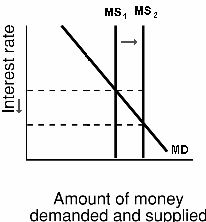
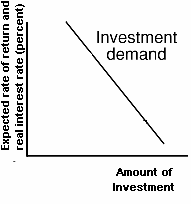
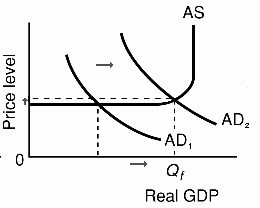
![]() DR)
DR)![]() RR)
RR)
II. Balance Sheet of the Fed
A. two major Assets1. Securities which are federal government bonds purchased by Fed, and2. Loans to commercial banks (Note: again commercial banks term is used even though the chapter analysis also applies to other thrift institutions.)
B. three major Liabilities
1. Reserves of banks held as deposits at Federal Reserve Banks,2. U.S. Treasury deposits of tax receipts and borrowed funds, and
3. Federal Reserve Notes outstanding, our paper currency.

ASSETS
|| LIABILITIES
Securities
|| Reserves of banks
Loans to banks
|| Treasury deposits
other
|| Federal Res. Notes
|| other
III. The Tools of Monetary Policy
A. Three Tools of the Fed over the Money Supply1. open market operations (OMO)
2. changing the reserve ratio (RR)
3. changing the discount rate (DR)B. Open Market Operations
1. definitionOpen-market operations refer to the Fed’s buying and selling of government bonds.2. buying securities
Buying securities will increase bank reserves and the money supplya. Example: Assume that the Fed buys a $1000 bond (security) from a commercial bank (RR = 20%)1) then bank reserves go up by the value of the securities sold to the Fed.2) impact on balance sheets
Balance Sheet of the Fed
ASSETS
|| LIABILITIES
Securities
+ $1000
|| Reserves of banks
+ $1000
Loans to banks
|| Treasury deposits
other
|| Federal Res. Notes
|| other
Balance Sheet of the Banking System
ASSETS
|| LIABILITIES
Reserves at Fed
+ $1000
Req Res
+0
ER
+1000
|| Demand Deposits
Cash in vault
|| Other Deposits
Loans
|| Loans from Fed
Securities
- $1000
|| other
Other
|| 4) more excess reserves increases Bank's lending ability -- remember when banks make loans they creat money
5) Total change in the money supply:
MS = initial ER x money multiplier
- money multiplier = 1 / RR = 1/.2 = 5
- SO:
MS = + $1000 x 5 = + $5000
6) Textbook Figure 14.2
b. Example: Assume that the Fed buys a $1000 bond (security) from the general public (RR = 20%)
1) people receive checks from the Fed and then deposit the checks at their bank. Bank customer's deposits rise and therefore bank reserves rise by the same amount. NOTE: this $1000 in new demand deposits is NEW MONEY2) impact on balance sheets
Balance Sheet of the Fed
ASSETS
|| LIABILITIES
Securities
+ $1000
|| Reserves of banks
+ $1000
Loans to banks
|| Treasury deposits
other
|| Federal Res. Notes
|| other
Balance Sheet of the Banking System
ASSETS
|| LIABILITIES
Reserves at Fed
+ $1000
Req Res
+200
ER
+800
|| Demand Deposits
+ $ 1000
(this is new M1 money)Cash in vault
|| Other Deposits
Loans
|| Loans from Fed
Securities
|| other
Other
||
4) Total change in the money supply:
MS = initial ER x money multiplier
- money multiplier = 1 / RR = 1/.2 = 5
- SO:
MS = + $ 800 x 5 = + $ 4000 PLUS the initial $1000 of new money created when the fed paid the public for the gov't security = $ 5000
4) Textbook Figure
c. Conclusion:
When the Fed buys securities, bank reserves will increase and the money supply potentially can rise by a multiple of these reserves.The Fed pays for the securities with new Excess Resources (ER)
MS = initial ER x money multiplier
OR
MS = value of securities bought x money multiplier
The Fed would do this to fight unemployment (UE)
3. When the Fed sells securities:
a. the points above will be reversed.b. Bank reserves will go down, and eventually the money supply will go down by a multiple of the banks’ decrease in reserves.
c. they would do this to fight inflation (IN)
Three tools of the fed:
1. OMO
2. RR
3. DRC. Changing the Reserve Ratio
1. raising the reserve ratioa. Raising the reserve ratio increases required reserves and shrinks excess reserves.b. Any loss of excess reserves shrinks banks’ lending ability and, therefore, DECREASES the potential money supply by a multiple amount of the change in excess reserves.
2. lowering the reserve ratio
a. Lowering the reserve ratio decreases the required reserves and expands excess reserves.b. Gain in excess reserves increases banks’ lending ability and, therefore, INCREASES the potential money supply by a multiple amount of the increase in excess reserves.
3. EXAMPLE: What happens if the fed lowers the RR from 20% to 10% ?
Initially assume
- RR = 20%
- and the banking system has the following balance sheet
Balance Sheet of the Banking System
ASSETS
|| LIABILITIES
Reserves
$ 25,000
Req Res
20,000
ER
5,000
|| Demand Deposits
$ 100,000
Loans
$30,000
|| |
Securities
$ 45,000
|| |
MS?
Formulas:
MS = initial ER x money multiplier (always start with this formula)
- ER = Total Reserves - Required Reserves
- money multiplier = 1/RR
- Required Reserves = RR x Liabilities
Solution:
- Required Reserves = RR x Liabilities = .2 x $ 100,000 = $ 20,000
- ER = Total Reserves - Required Reserves = $25,000 - $ 20,000 = $ 5,000
- money multiplier = 1 / RR = 1/0.2 = 5
MS = initial ER x money multiplier = $ 5,000 x 5 = $ 25,000
ANSWER: MS can increase by $ 25,000
What happens if the Fed LOWERS the DR to 10%?
Now:
- RR = 10%
- initially the banking system has the following balance sheet
Balance Sheet of the Banking System
ASSETS
|| LIABILITIES
Reserves
$ 25,000
Req Res
10,000
ER
15,000
|| Demand Deposits
$ 100,000
Loans
$30,000
|| |
Securities
$ 45,000
|| |
MS?
Formulas:
MS = initial ER x money multiplier
- ER = Total Reserves - Required Reserves
- money multiplier = 1/RR
- Required Reserves = RR x Liabilities
Solution:
- Required Reserves = RR x Liabilities = .1 x $ 100,000 = $ 10,000
- ER = Total Reserves - Required Reserves = $25,000 - $ 10,000 = $ 15,000
- money multiplier = 1 / RR = 1/0.1 = 10
MS = initial ER x money multiplier = $ 15,000 x 10 = $ 150,000
ANSWER: MS can increase by $ 150,000
4. Changing the reserve ratio has two effects:
a. It affects the size of excess reserves.b. It also changes the size of the monetary multiplier. For example, if ratio is lowered from 20 percent to 10 percent, the multiplier increases from 5 to 10.
5. Changing the reserve ratio is very powerful since it affects banks’ lending ability immediately. It could create instability, so Fed rarely changes it.
6. Table 16-2 provides illustrations.

Three tools of the fed:
1. OMO
2. RR
3. DRD. Discount Rate
1. Definition: the interest rate that the Fed charges to commercial banks that borrow from the Fed.2. An increase in the discount rate signals that borrowing reserves is more difficult and will tend to shrink excess reserves.
3. A decrease in the discount rate signals that borrowing reserves will be easier and will tend to expand excess reserves.
IV. Monetary Policy and the Monetary Policy Cause Effect Chain (graphs)
A. "Easy" or expansionary monetary policy1. occurs when the Fed tries to increase money supply by expanding excess reserves in order to stimulate the economy.2. GOAL: to reduce unemployment
3. The Fed will enact one or more of the following measures.
a. The Fed will buy securities.b. The Fed may reduce reserve ratio, although this is rarely changed because of its powerful impact.
c. The Fed could reduce the discount rate, although this has little direct impact on the money supply.
4. Expansionary or easy money policy: The Fed takes steps to increase excess reserves, banks can make more loans increasing the money supply, which lowers the interest rate and increases investment which, in turn, increases GDP by a multiple amount of the change in investment.
Keynesian Cause-Effect Chain of Monetary
Policy: FED
BUY OMO
TOOLS ![]()
![]() ER
ER![]()
![]() MS
MS
![]()
![]() Int.
Rates
Int.
Rates![]()
![]() I
I
![]()
![]() AD
AD
![]()
![]()
![]() real
GDP
real
GDP ![]()
![]() UE
UE
![]() PL
PL
![]()
![]() IN
IN
![]() DR
DR
![]() RR
RR

B. "Tight" or contractionary monetary policy1. occurs when Fed tries to decrease money supply by decreasing excess reserves in order to slow spending in the economy during an inflationary period.2. GOAL: to reduce inflation
3. The Fed will enact one or more of the following policies:
a. The Fed will sell securities.b. The Fed may raise the reserve ratio, although this is rarely changed because of its powerful impact.
c. The Fed could raise the discount rate, although it has little direct impact on money supply.
4. Contractionary or tight money policy is the reverse of an easy policy: Excess reserves fall, the money supply decreases, which raises interest rate, which decreases investment, which, in turn, decreases GDP by a multiple amount of the change in investment.
Keynesian Cause-Effect Chain of Monetary
Policy: FED
SELL OMO
TOOLS ![]()
![]() ER
ER![]()
![]() MS
MS
![]()
![]() Int.
Rates
Int.
Rates![]()
![]() I
I
![]()
![]() AD
AD
![]()
![]()
![]() real
GDP
real
GDP ![]()
![]() UE
UE
![]() PL
PL
![]()
![]() IN
IN![]() DR
DR
![]() RR
RR

C. Textbook Graph (figure 16.5)
Graph 1 Graph 2 Graph 3

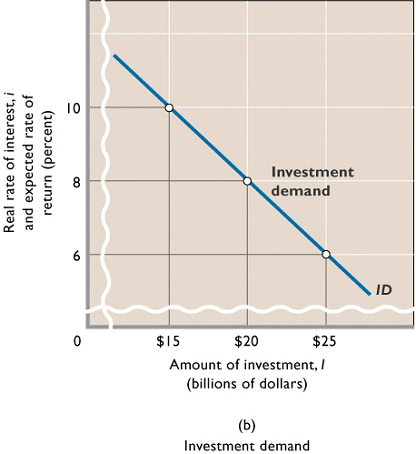
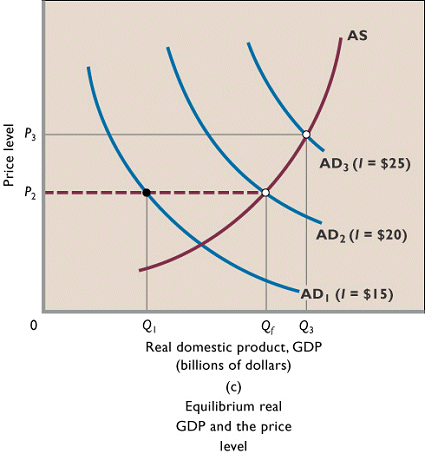
1. Using the textbook's "Key Graph 16.5", how would we illustrate expansionary MP?a. If the MS is Sm1 in graph 1
- so the equilibrium interest rate is 10% (graph 1)
- with a 10% interest rate the initial amount of investment is $15 billion (graph 2)
- with I = $15 billion the initial AD is AD1 (graph 3)
b. Fed either:
- buys securities
- lowers the DR
- lowers the RR
c. this increases ER and increases the MS from Sm1 to Sm2 (graph 1)
d. interest rates fall from 10% to 8% (graph 1)
e. when interest rates fall, the amount of I increases from $15 billion to $20 billion (graph 2)
f. this $5 billion increase in investment will increase AD from AD1 to AD2 (graph 3)
g. THEREFORE, real GDP increases from Q1 to Qf
h. Review chapter 10.
- if Q1 = $400 billion
- and if MPC = 0.8
- what is Qf?
2. Using the textbook's "Key Graph 16.5", how would we illustrate contractionary MP?
a. If the MS is Sm3 in graph 1
- so the equilibrium interest rate is 6% (graph 1)
- with a 10% interest rate the initial amount of investment is $25 billion (graph 2)
- with I = $25 billion the initial AD is AD3 (graph 3)
b. Fed either:
- sells securities
- raises the DR
- raises the RR
c. this decreases ER and decreases the MS from Sm3 to Sm2 (graph 1)
d. interest rates rise from 6% to 8% (graph 1)
e. when interest rates rise, the amount of I decreases from $25 billion to $20 billion (graph 2)
f. this $5 billion decrease in investment will decrease AD from AD3 to AD2 (graph 3)
g. THEREFORE, real GDP decreases from Q3 to Qf
h. Review chapter 10.
- if Q1 = $450 billion
- and if MPC = 0.8
- what is Qf?
D. For several reasons, open-market operations give the Fed most control of the three "tools."
1. Open-market operations are most important.
- This decision is flexible because securities can be bought or sold quickly and in great quantities.
- Reserves change quickly in response.
2. The reserve ratio is rarely changed since this could destabilize bank’s lending and profit positions.
3. Changing the discount rate has little direct effect,
- since only 2-3 percent of bank reserves are borrowed from Fed.
- At best it has an "announcement effect" that signals direction of monetary policy.
E. SUMMARY: Monetary Policies for Recession and Inflation -- TABLE 16.3
E. Quick Quiz.
V. Effectiveness of Monetary Policy
A. Changes in the price level changes the effectiveness of monetary policy
1. Easy monetary policy may be inflationary if initial equilibrium is at or near full-employment. (AD3 to AD4)2. If economy is below full-employment, easy monetary policy can shift aggregate demand and GDP toward full-employment equilibrium. with little effect on inflation (AD1 to AD2)
3. A tight monetary policy can reduce inflation with little effect on unemployment if economy is near or above full-employment (AD6 to AD5)
4. A tight monetary policy can make unemployment worse in a recession. (AD2 to AD1)
B. Strengths of Monetary Policy
1. It is speedier and more flexible than fiscal policy since the Fed can buy and sell securities daily.2. It is less political. Fed Board members are isolated from political pressure, since they serve 14-year terms, and policy changes are more subtle and not noticed as much as fiscal policy changes. It is easier to make good, but unpopular decisions.
C. Focus on the Federal Funds Rate.
1. Currently the Fed communicates changes in monetary policy through changes in its target for the Federal funds rate.2. Definition
- The Fed Funds rate is the interest rate that banks pay other banks for overnight loans
- some banks may have ER left over at the end of the day on reserve at the Fed
- other banks may not have enough reserves to meet their required reserves
3. The Fed does not set either the Federal funds rate or the prime rate; each is established by the interaction of lenders and borrowers, but rates generally follow the Fed funds rate.
4. The Fed acts through open market operations, selling bonds to raise interest rates and buying bonds to lower interest rates
D. Recent monetary policy.
1. Easy money policy in the early 1990s helped produce a recovery from the 1990-1991 recession and the expansion that lasted until 2001.2. Tightening in 1994, 1995, and 1997 helped ease inflationary pressure during the expansion.
2. To counter the recession that began in March 2001, the Fed pursued an easy money policy that saw the prime interest rate fall from 9.5 percent at the end of 2000 to 4.25 percent in December 2002.
4. The Fed has been praised for helping the U.S. economy maintain simultaneously full employment, price stability, and economic growth for over four years.
5. They have also received credit for swift and strong responses to the September 11, 2001, terrorist attacks, significant declines in the stock market
E. Problems and Complications
1. Recognition and operational lags impair the Fed's ability to quickly recognize the need for policy change and to affect that change in a timely fashion.
- Although policy changes can be implemented rapidly (short administrative lag), there is a lag of at least 3 to 6 months before the changes will have their full impact.
2. CYCLICAL ASYMMETRY may exist: a tight monetary policy works effectively to brake inflation, but an easy monetary policy is not always as effective in stimulating the economy from recession.
- Japan's ineffective easy money policy illustrates the potential inability of monetary policy to bring an economy out of recession. While pulling on a string (tight money policy) is likely to move the attached object to its desired destination, pushing on a string is not.
3. CHANGES IN VELOCITY: The velocity of money (number of times the average dollar is spent in a year) may be unpredictable, especially in the short run and can offset the desired impact of changes in money supply. Tight money policy may cause people to spend faster; velocity rises.
4. The IMPACT ON INVESTMENT may be less than traditionally thought. Japan provides a case example. Despite interest rates of zero, investment spending remained low during the recession.
Also see: http://money.cnn.com/2003/06/11/news/economy/borrowing_slump/index.htm
F. Currently the Fed communicates changes in monetary policy through changes in its target for the Federal funds rate. (Key Question 5)
1. The Fed does not set either the Federal funds rate or the prime rate; each is established by the interaction of lenders and borrowers, but rates generally follow the Fed funds rate.
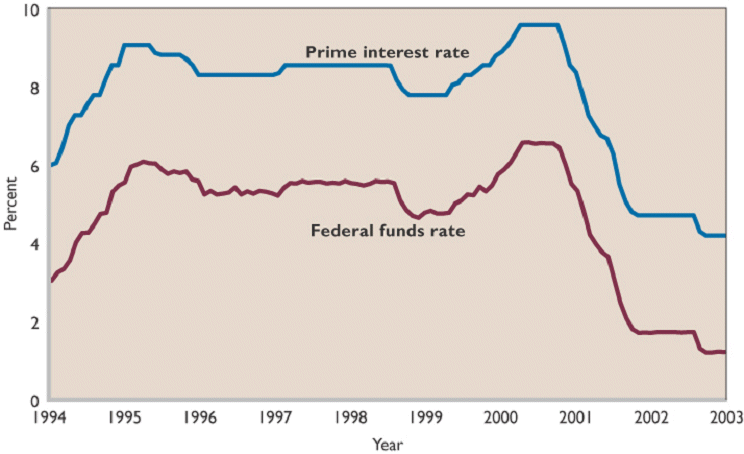
2. The Fed acts through open market operations, selling bonds to raise interest rates and buying bonds to lower interest rates.G. Monetary policy and the international economy:
1. Net export effect occurs when foreign financial investors respond to a change in interest rates.a. Tight monetary policy and higher interest rates1) lead to appreciation of dollar value in foreign exchange markets;2) When dollar appreciates, American goods become more costly to foreigners, and this lowers demand for U.S. exports, which tends to lower GDP.
3). This is the desired effect of a tight money policy.
b. an easy money policy and lower interest rates
1) leads to depreciation of dollar,2) greater demand for U.S. exports and higher GDP.
3). This policy has the desired outcome for expanding GDP.
2. Table 16-3 illustrates these points.
3. FP vs. MP and the international economy
a Expansionary FP:1) goal to increase AD and reduce UE2) net export effect
- gov't borrowing can cause higher interest rates, which causes
- greater demand for the dollar by foreigners, which causes
- the DOLLAR to APPRECIATE, which causes
- US imports to increase and US exports to decrease, which
- will DECREASE AD and
- REDUCES THE EFFECTIVENESS of the expansionary FP (SMALLER MULTIPLIER)
b. Easy MP:
1) goal to increase AD and reduce UE2) with the international economy
- increasing the MS causes lower interest rates, which causes
- less demand for the dollar by foreigners, which causes
- the DOLLAR to DEPRECIATE, which causes
- US imports to decrease and US exports to increase, which
- will INCREASE AD
- INCREASES THE EFFECTIVENESS of the easy MP.